
APRIL 2022
Future Forum Pulse
Inflexible return-to-office policies are hammering employee experience scores
New data shows work-related stress and anxiety is skyrocketing
among full-time office workers and those without schedule flexibility
Read through the report by clicking the sections below, or download the full report as a PDF.
Future Forum is a consortium focused on building a way of working that is flexible, inclusive, and connected. We conduct research and convene executives to design a people-centered and digital-first workplace. In June 2020, Future Forum began surveying thousands of workers and managers globally on a quarterly basis, asking them a series of questions related to productivity, sense of belonging, and preferred ways of working. This report summarizes the findings of the Spring 2022 Future Forum Pulse, a survey of 10,818 knowledge workers across the U.S., Australia, France, Germany, Japan, and the U.K. conducted from January 27 to February 21, 2022.
Return-to-office policies are negatively impacting employee experience scores
As companies implement return-to-office policies, calling more employees back to the office, knowledge workers’ work-related stress and anxiety has hit the highest levels since our surveying began in the summer of 2020.
- More than a third of knowledge workers (34%) have reverted to working from the office five days a week, the greatest share since Future Forum began surveying in June 2020.
- With this shift, scores have dropped to near-record lows across all eight employee experience measures that we survey. Work-related stress and anxiety is at its worst since our surveying began, dropping 28% compared with last quarter, while work-life balance dropped 17% quarter over quarter.
Full-time office workers report the steepest declines
While employee experience scores fell for all knowledge workers—likely due, at least in part, to concerns and challenges around the spread of the Omicron variant of COVID-19—full-time office workers, who already ranked behind remote and hybrid employees on the eight key sentiment measures in the Pulse survey, posted the steepest declines, including:
- 2x as steep a decline in work-life balance, compared to flexible (hybrid and remote) workers.
- 1.6x as steep a decline in overall satisfaction with their working environment, compared to flexible workers.
- 1.5x worsening work-related stress and anxiety, compared to remote workers.
A troubling double standard for the C-suite
Executives say they want to work from the office—but it’s their employees who are being told to show up.
- Non-executive employees are nearly twice as likely as executives to be working from the office five days a week.
- Non-executives’ work-life balance scores are now 40% worse than their bosses, plummeting at five times the rate of executives over the last quarter.
- Non-executives are also reporting more than twice the level of work-related stress and anxiety as executives.
Rigid policies are likely to drive attrition, particularly among underrepresented groups
- Knowledge workers with little to no ability to set their own work hours are 2.6x as likely to look for a new job in the coming year, compared to those with schedule flexibility.
- This effect could be most pronounced among women, people of color, and working parents (especially working mothers), who continue to report the greatest interest in flexible schedules and working locations. The percentage of women who say that they want to work flexibly at least three days a week is 58% this quarter, compared to 48% of men. Meanwhile, the number of working mothers who say that they want location flexibility rose to 82%, an all-time high since Future Forum began surveying.
This quarter, as many companies began calling their employees back to the office amid continued uncertainty around the Omicron variant, employee experience scores plummeted—particularly for knowledge workers who have been asked to return to the office full-time and for those who have little to no flexibility to set their own work schedules.
The data shows that more than a third of knowledge workers (34%) have reverted to working from the office five days a week, the greatest share since Future Forum began surveying in June 2020. With this shift, employee sentiment has dropped to near-record lows, including 28% worse scores on work-related stress and anxiety and 17% worse scores on work-life balance (compared to the previous quarter).

The Future Forum Pulse measures how knowledge workers feel about their working lives across eight dimensions on an index from –60 (most negative) to +60 (most positive).
In the U.S., work-life balance is at an all-time low and work-related stress and anxiety is at an all-time high since the inception of our survey, an abrupt about-face from the previous quarter.
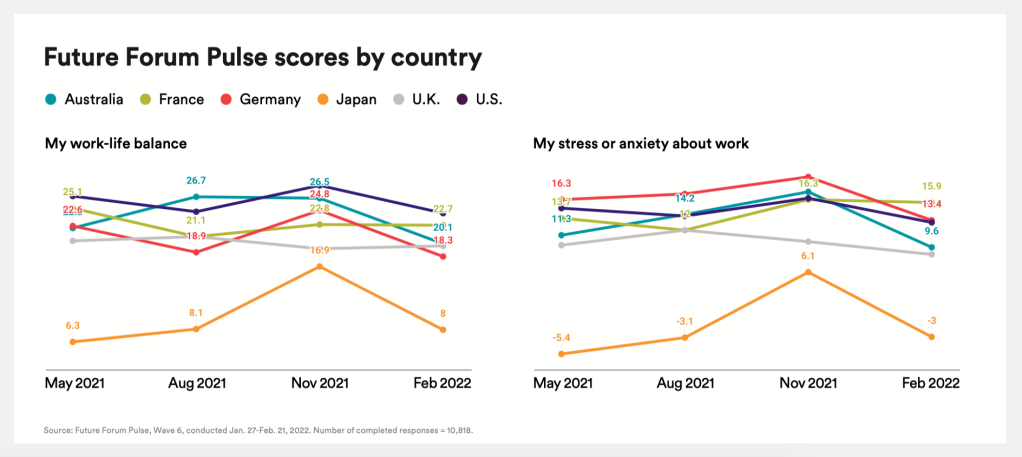
In every country except France and Japan, employees report all-time high scores for work-related stress.
The data also indicates that employers will pay a price for this discontent: Workers who say that they are unsatisfied with their current level of flexibility—both in where and when they work—are now three times as likely to say they will “definitely” look for a new job in the coming year, compared to those who report satisfaction with their work flexibility.
“Leaders need to move away from dictating days in the office and rigid 9-to-5 schedules, and focus instead on aligning their teams around a common purpose and leading by example,” says Brian Elliott, executive leader of Future Forum. “Trusting your teams with the flexibility to work where and when works best for them will lead to better business results and happier employees.”
In our last quarterly report, we noted that flexibility in both location and schedule had become the expectation and increasingly the norm among global knowledge workers. During that time, as of November 2021, less than a third (30%) of all knowledge workers were working full-time in the office—and 68% of all knowledge workers said they prefer hybrid work.
But this quarter, more employees have been called back to the office, whether willingly or unwillingly. The number of employees working in hybrid arrangements has dropped from over 50% to 45%, and the number of knowledge workers who are working in the office five days a week has risen to 34%, the highest level since we first started surveying in June 2020.
And the data suggests that the majority of full-time office workers are most likely there unwillingly; as of this quarter, the percentage of fully in-person office workers who say they would prefer to work flexibly at least part of the time has jumped to 55%.
At the same time, employee sentiment and experience scores for fully in-person knowledge workers (already the lowest across the board compared to hybrid or fully remote employees) plummeted this quarter.
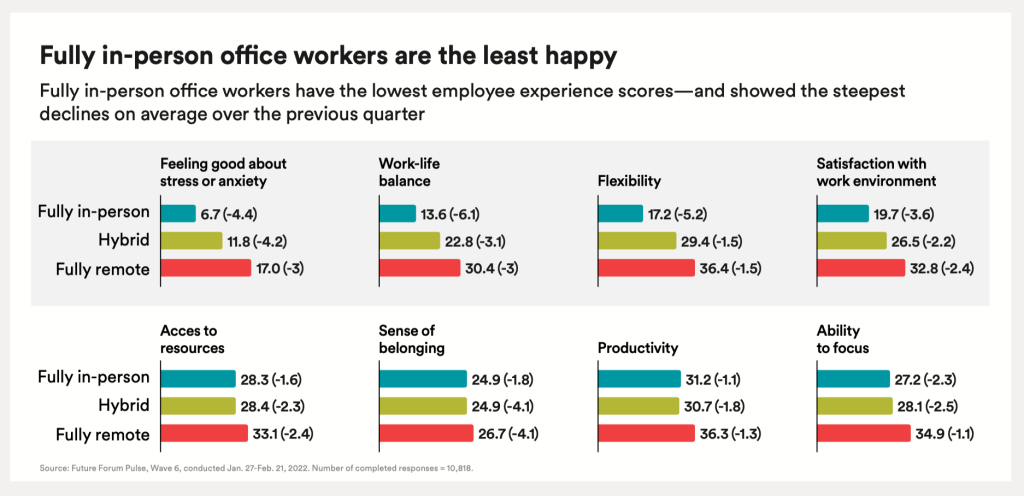
Full-time office workers showed 2x as steep a decline in work-life balance, compared to flexible (hybrid and remote) workers. They showed 1.6x as steep a decline in overall satisfaction with their working environment, compared to flexible workers. And they showed 1.5x worse scores for work-related stress and anxiety, compared to remote workers.
Data from the Pulse survey shows that non-executives are facing far more strain during the return-to-office era than leaders in the C-suite, further widening the existing executive-employee disconnect on key job satisfaction measures.
Non-executives’ work-life balance scores are now 40% worse than their bosses, plummeting at five times the rate of executives over the last quarter. Non-executives are also reporting more than twice the level of work-related stress and anxiety as executives.
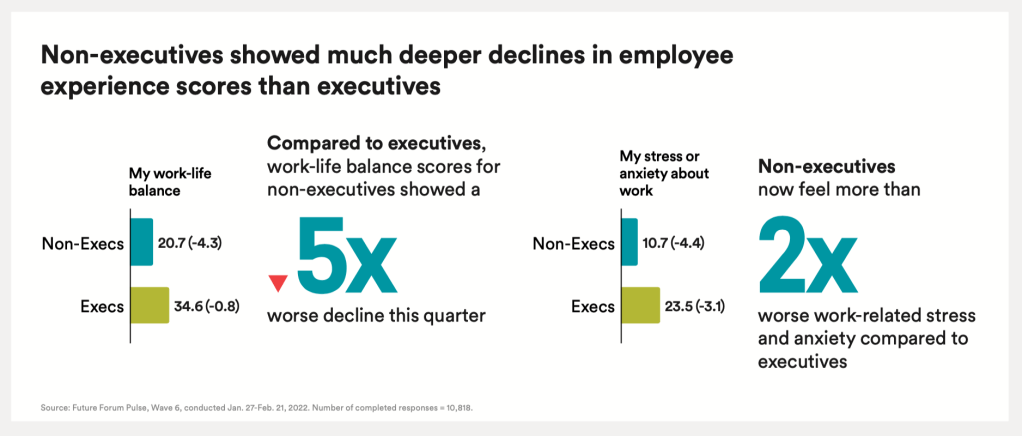
There is a large and growing disconnect between non-executive knowledge workers’ desired flexibility and what they’re getting when compared with executives. Only about one in every five knowledge workers (21% of both executives and non-executives alike) say they want to work in the office full-time. But when it comes to where people are actually working, non-executives are nearly two times more likely than executives to work full-time in the office; 35% of non-executives surveyed are making the five-day-a-week commute, compared to 19% of executives.
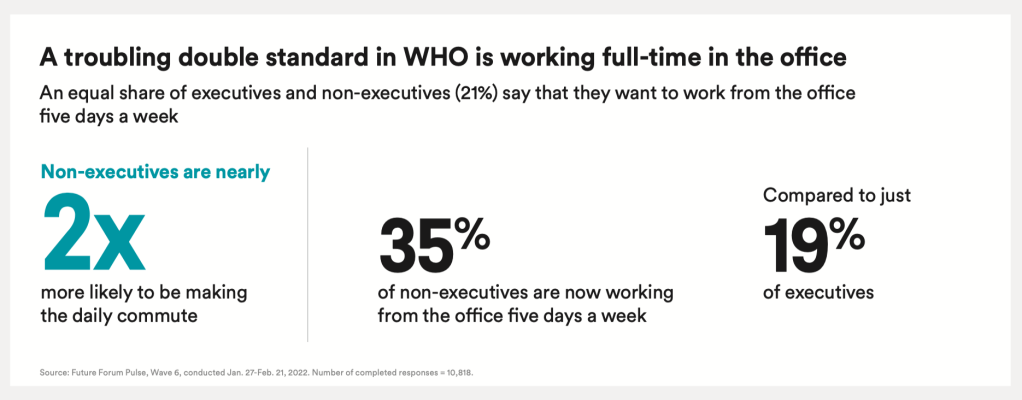
Executives are also failing to offer the transparency and clarity that employees are asking for. Knowledge workers who say their employer is not being “transparent about their future-of-work plans” are more than three times as likely to say they will “definitely” seek a new employer in the coming year.
Employees who say their company has not provided a policy on flexibility are the most likely to say they will “definitely” look for a job in the coming year—even more than employees who say their company doesn’t allow remote work. In other words, employees are less likely to leave if policies are clear, even if the rules do not align with what they say they want.
“Employees have clearly proven that they can get the job done while having flexibility in their work lives. If executives roll back this flexibility—or put off key decisions on the options that employees will have going forward—they’re setting themselves up for a wave of departures,” says Deborah Lovich, a managing director and senior partner at Boston Consulting Group.
Psychological reactance in action
Psychological reactance is a negative reaction to rules and regulations that threaten or eliminate specific behavioral freedoms. It occurs when a person feels that someone or something is taking away their choices or limiting the range of alternatives.
For many companies, return-to-office conversations have focused almost exclusively on the “where” instead of the “when” of work, overlooking the critical importance of schedule flexibility. Today, 79% of knowledge workers say they want location flexibility. But more than 9 out of 10 knowledge workers—94%—say they want schedule flexibility.
Knowledge workers with flexibility are lower flight risks and happier employees, yet more than half (51%) of knowledge workers say their company doesn’t provide flexible working hours, and nearly two-thirds (65%) say that they personally have little to no ability to adjust their hours from a pre-set schedule, outside of the occasional doctor’s appointment.
Pulse data shows that this kind of schedule rigidity can have significant adverse impacts on an employee’s overall experience at work. Knowledge workers who say they have little to no ability to set their own hours report 1.7x worse work-life balance, 2.2x worse work-related stress and anxiety, and 1.4x worse burnout.
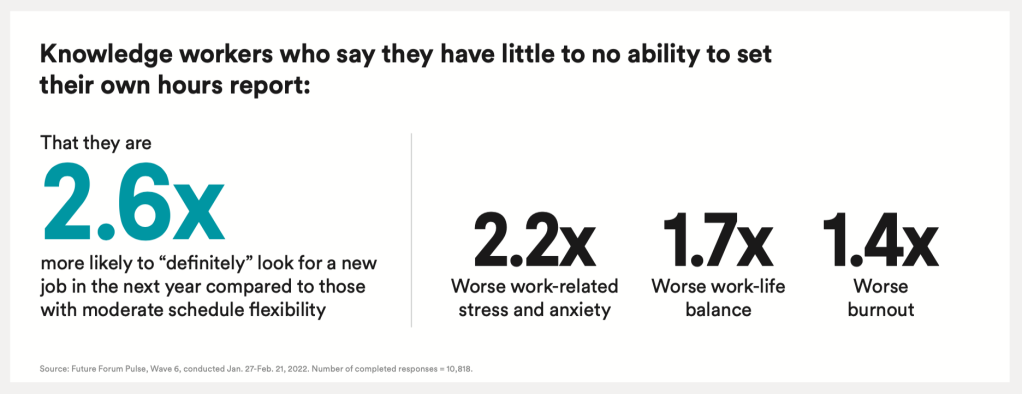
If not addressed, this gap between what knowledge workers want and what employers are willing to give portends continued drops in employee experience and yet another wave of resignations as workers seek employment at companies that offer the flexible working options they’re looking for.
Knowledge workers without location flexibility are 20% more likely to look for a new position in the next year compared to knowledge workers with full location flexibility.
And knowledge workers who say they have little to no ability to set their own hours are 2.6x as likely to “definitely” look for a new job in the next year (compared to those with moderate schedule flexibility).
Offering employees flexibility is emerging as a meaningful way to move the needle in a positive direction on diversity, equity, and inclusion (DEI). Flexibility continues to be most prized by those who have been underrepresented in knowledge work, including women, people of color, and working mothers. Thirty-eight percent of Black male employees and 33% of Black female employees would prefer a fully flexible schedule, compared to 25% of white female employees and 26% of white male employees.

But this quarter, with many employers calling their workers back to offices, women and working moms are expressing their desire for location flexibility more than ever. The number of women who say they want to work remotely three to five days a week rose at a rate two and a half times that of men this quarter, widening the gap in sentiment between men and women on location preference. Fifty eight percent of women want to work remotely 3 to 5 days a week (up from 52% in November) compared to 48% of men (up from 46% in November).
The number of working moms who say they want location flexibility also significantly grew this quarter. Eighty-two percent of working moms want location flexibility, a three percentage point rise and the highest level of interest since we first started surveying, compared with 80% of working dads and women without children and 74% of men without children. And 57% of working mothers want to work remotely 3 to 5 days a week (up from 50% in November) compared to 48% of working fathers (up from 43% in November).
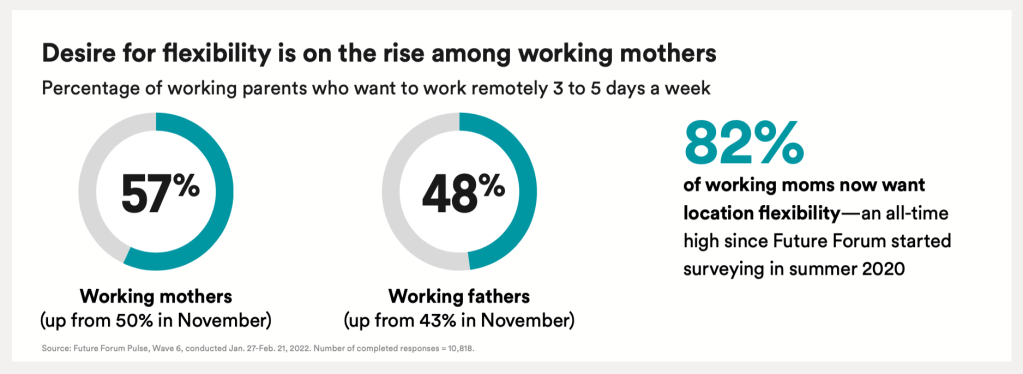
Parents are particularly concerned about career progression and remote work, with 46% of working parents worried that working remotely will have a negative impact on their careers, compared to 34% of non-parents. Working parents are also more likely than non-parents to experience bias at work, with 29% of working dads and 26% of working moms saying they have been negatively impacted by bias in the workplace in the past year, compared to 23% of male and female non-parents.

Achieve balance between company control and employee choice
Flexibility, especially schedule flexibility, will succeed only if one is willing to set aside outdated conceptions of how work should be done. But with so many different ideas about what flexibility can mean to each person, team, and company, it can be hard to band together to create this kind of shift.
So where to start? We urge leaders to begin by identifying your purpose: Why do you want to enable flexible work in the first place? Clearly articulate that reason, and then align your entire leadership team behind it.
It’s in those often messy debates about how flexible work will support your business objectives that you begin to build alignment among your leadership team. You can then translate that purpose into a set of core principles and behavioral guidelines that will help you introduce your flexible work strategy to your organization, while allowing each team the autonomy to devise the specific practices that work best for them.
Embrace schedule flexibility for all
The most successful companies are establishing core collaboration hours when people are expected to either be in the office or online for synchronous collaboration. They are setting up asynchronous collaboration methods to reduce the burden of being “always on” and feeling pressure to constantly show up for meetings. Survey respondents who say “I spend too much time in meetings” are 38% more likely to experience burnout.
To prevent burnout, managers need to set clear team-level agreements that respect schedules and time zones. Employees who say, “I feel pressure to let my colleagues know I am ‘at work’ and being productive” and “I feel pressure to respond to messages quickly, even if they’re sent after standard working hours” are nearly twice as likely to experience burnout. And managers need to lead by example so there is no double standard.
Normalize a culture of learning
This is uncharted territory for all executives, so it is time to start exploring, see what works, and experiment, experiment, experiment! Iterate on new ways of working, celebrate small wins as you go, and aim for progress, not perfection.
Those who “wait and see what others do” will be left behind. At every step of the way, be clear what your policies are. Our Pulse survey data shows that people are more likely to look for a new position at companies that don’t have a policy regarding employees working from home compared to companies with a clear policy—even one that prohibits working from home.
An earlier version of this report incorrectly listed the percentages of Hispanic/Latinx and Black knowledge workers who prefer a hybrid or fully remote work arrangement. The accurate percentages are 81% for Black respondents and 79% for Hispanic/Latinx respondents.
Australia
In Australia, more survey respondents are working either fully remote or hybrid, compared to the global average. More workers in Australia say they’re very likely to seek employment at another company in the next 12 months than the global average.Where are people working?
1. Where are people working?

2. What is the desire for location flexibility?
I would prefer to work at my company’s office …

3. What is the desire for schedule flexibility?

4. How likely are you to look for a new job at another company in the next 12 months?

France
In France, slightly more survey respondents are back in the office full time, compared to the global average. Fewer workers in France say they’re very likely to seek employment at another company in the next 12 months than the global average.
1. Where are people working?

2. What is the desire for location flexibility?
I would prefer to work at my company’s office …

3. What is the desire for schedule flexibility?

4. How likely are you to look for a new job at another company in the next 12 months?

Germany
In Germany, more survey respondents are working either fully remote or hybrid, compared to the global average. Fewer workers in Germany say they’re very likely to seek employment at another company in the next 12 months than the global average.
1. Where are people working?

2. What is the desire for location flexibility?
I would prefer to work at my company’s office …

3. What is the desire for schedule flexibility?

4. How likely are you to look for a new job at another company in the next 12 months?

Japan
In Japan, more survey respondents are back in the office full time, compared to the global average. Fewer workers in Japan say they’re very likely to seek employment at another company in the next 12 months than the global average.
1. Where are people working?

2. What is the desire for location flexibility?
I would prefer to work at my company’s office …

3. What is the desire for schedule flexibility?

4. How likely are you to look for a new job at another company in the next 12 months?

U.K.
In the U.K, more survey respondents are working either fully remote or hybrid, compared to the global average. More workers in the U.K. say they’re very likely to seek employment at another company in the next 12 months than the global average.
1. Where are people working?

2. What is the desire for location flexibility?
I would prefer to work at my company’s office …

3. What is the desire for schedule flexibility?

4. How likely are you to look for a new job at another company in the next 12 months?

U.S.
In the U.S., slightly fewer survey respondents are working either fully remote or hybrid, compared to the global average. More workers in the U.S. say they’re very likely to seek employment at another company in the next 12 months than the global average.
1. Where are people working?

2. What is the desire for location flexibility?
I would prefer to work at my company’s office …

3. What is the desire for schedule flexibility?

4. How likely are you to look for a new job at another company in the next 12 months?

Source: Future Forum Pulse, Wave 6, conducted Jan. 27-Feb. 21, 2022. Number of completed responses = 10,818.
Methodology
This Future Forum Pulse surveyed 10,818 knowledge workers in the U.S., Australia, France, Germany, Japan, and the U.K. between January 27 and February 21, 2022. The survey was administered by Qualtrics and did not target Slack employees or customers. Respondents were all knowledge workers, defined as employed full-time (30 or more hours per week) and either having one of the roles listed below or saying they “work with data, analyze information, or think creatively”: Executive Management (e.g., President/Partner, CEO, CFO, C-suite), Senior Management (e.g., Executive VP, Senior VP), Middle Management (e.g., Department/Group Manager, VP), Junior Management (e.g., Manager, Team Leader), Senior Staff (i.e., Non-Management), Skilled Office Worker (e.g., Analyst, Graphic Designer).
The Future Forum Pulse measures how knowledge workers feel about their working lives on a five-point scale (from “very poor” to “very good”) across eight dimensions on an index from –60 (most negative) to +60 (most positive).
10K+
knowledge workers
6
countries